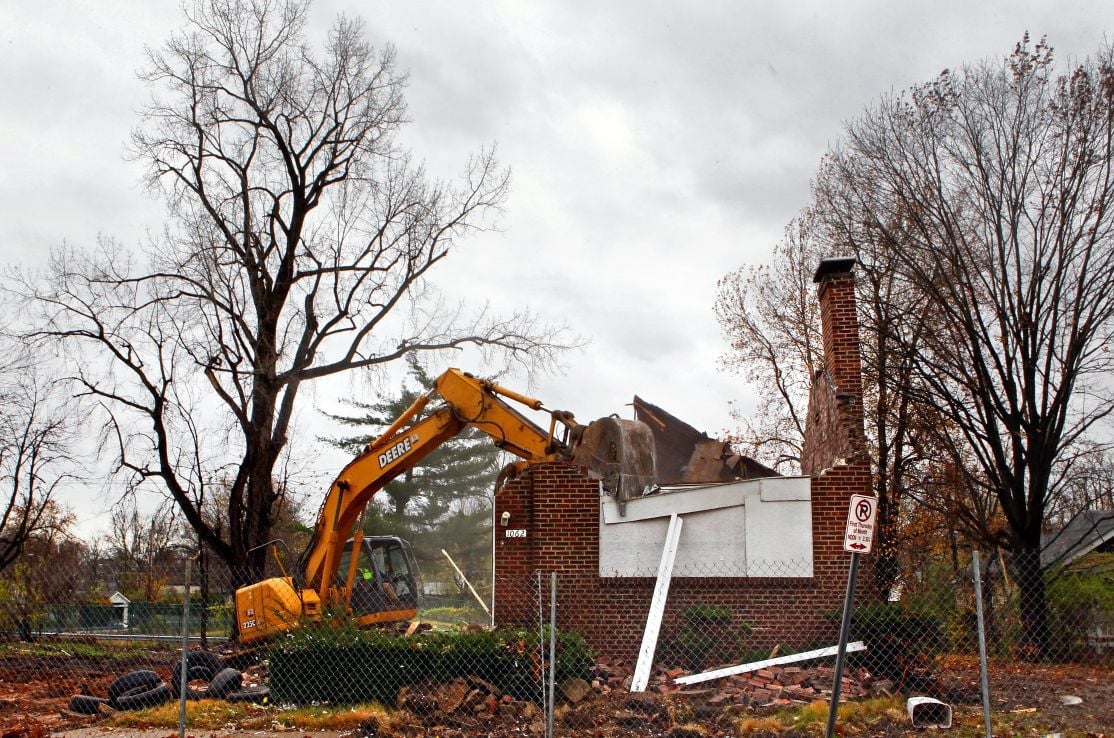ST. LOUIS ŌĆó More than a year after announcing a proposal to supplement the cityŌĆÖs budget to demolish abandoned properties, the regionŌĆÖs sewer district and the city are finally moving forward with a program.
The Metropolitan ├█č┐┤½├Į Sewer District introduced an ordinance to its board of trustees Thursday to enter into an agreement with ├█č┐┤½├ĮŌĆÖ Land Clearance for Redevelopment Authority. The city and MSD say they plan to identify areas where demolishing vacant property could add attractive green space to neighborhoods and help nudge redevelopment.
While the city and MSD are holding off on publicly identifying areas where extra demolitions might occur, sewer district spokesman Lance LeComb said there should be more details on some of the first targeted areas by next month.
ŌĆ£ThereŌĆÖs so many low-hanging fruit, it would be, particularly for the first 100 homes, it should be fairly easy to come to an agreement on which ones would come down,ŌĆØ LeComb said.
People are also reading…
MSDŌĆÖs interest in the program, , stems from its mandate under to cut sewage releases into area waterways. One way to do that is to reduce stormwater runoff from rooftops and pavement, which ultimately flows into the same pipes that handle sewage within ├█č┐┤½├Į. Heavy rains can overwhelm the treatment system and force raw sewage into the Mississippi River and its tributaries.
Meanwhile, the number of vacant properties in ├█č┐┤½├Į has been increasing since the recession. According to data from a ├█č┐┤½├Į building survey, vacant properties hit 7,184 in 2016, up more than 2,000 since the beginning of the decade.
As its population fell by more than half over the last half-century, the city has long struggled to keep up with deteriorating and abandoned housing stock left by people moving to the suburbs.
Last year, 377 buildings were demolished, excluding things such as garages and signs, about half the total in the early 2000s. Demolitions are up from a low of 235 in 2013 but as budgets have tightened, the city has far less money to spend on them.
├█č┐┤½├Į Building Commissioner Frank Oswald, whose office oversees the cityŌĆÖs demolition efforts, said there just arenŌĆÖt enough resources to keep up with the number of abandoned buildings, and he hopes the MSD money will help supplement the cityŌĆÖs efforts. Preliminary budgets call for keeping city demolition spending flat next year at $1 million, he said.
ŌĆ£On the north side, youŌĆÖre going to have substantial areas where MSD is working with our planning people to basically turn some of these areas into permanent green spaces,ŌĆØ Oswald said.
MSD says it plans to use up to $13.5 million for building demolition, but also for sodding and other green infrastructure to soak up rainwater. ItŌĆÖs targeting areas within the north and eastern portions of ├█č┐┤½├Į, where neighborhoods that struggle most with abandoned property are located.
The sewer district estimates it can spend $2 million to $3 million annually on demolitions. MSD hopes the program can ultimately pay to knock down about 1,000 abandoned buildings over several years, LeComb said.
The Environmental Protection Agency, which sued MSD in 2007 to force action on sewage overflows, gave the green light to the sewer districtŌĆÖs property demolition plan in the spring. It has taken more time than expected to sync up MSDŌĆÖs efforts with the city, LeComb said. ŌĆ£WeŌĆÖve probably let perfect stand in the way of good too much.ŌĆØ
But ├█č┐┤½├Į Planning and Urban Design Director Don Roe said work has started to try and make sure the MSD money goes as far as possible.
ŌĆ£These are buildings that are in tough shape,ŌĆØ Roe said. ŌĆ£WeŌĆÖre looking at where we get the greatest effectiveness, and part of that is by where they are clustered so we can make an impact on both the environmental needs for MSD and the social and economic needs.ŌĆØ
The program will be a small piece of that began in 2012 and will stretch to the late 2020s agreed to under the consent decree with EPA.
Vacant properties are a constant complaint from constituents, Alderman Jeffrey Boyd said. His ward in northwest ├█č┐┤½├Į has about 1,050 vacant buildings, the third-most in the city.
He lamented that $3 million pledged to vacant property demolition from a use tax passed by voters 15 years ago has been reduced over the years.
ŌĆ£It is absolutely not enough, and I am frustrated that we are not getting as much as we were promised when we voted for that use tax,ŌĆØ Boyd said.
While he wants to see a more comprehensive plan to save more of the cityŌĆÖs historic brick housing stock before it gets to the point of needing to be razed, heŌĆÖs glad for the extra money and said MSD has been good about communicating with his constituents.
ŌĆ£IŌĆÖm not sure why itŌĆÖs taken so long, but I do appreciate the process,ŌĆØ Boyd said.
In the 4th Ward, though, Alderman Sam Moore is not thrilled about MSDŌĆÖs plans.
His ward, encompassing the Greater Ville and Ville neighborhoods, has the most vacant structures in the city: 1,242 at the end of 2016. Since the late ŌĆÖ80s, more than 2,000 structures have been demolished in his ward, more than any other. Many properties could be saved, he said.
ŌĆ£Come in with some development if you want to help our community,ŌĆØ Moore said. ŌĆ£I have all this African-American history thatŌĆÖs being destroyed by demolition.ŌĆØ









